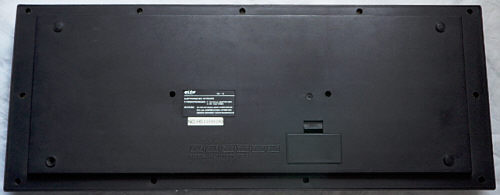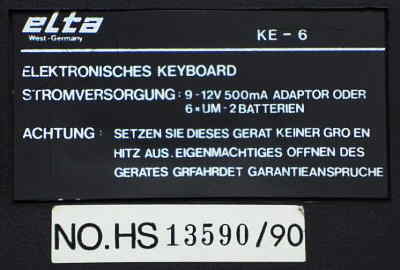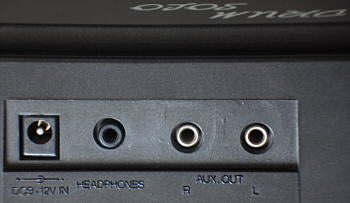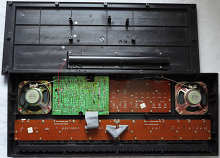This instrument from 1990 (PCB date) is basically a cross between the Letron MC-3 and the Testron (= Elta KE-5) and was apparently the direct successor of the latter. Most of its sounds and features correspond to the Testron, but it sounds less warm and has 5 drumpads (with programmable drum pattern), a separate accompaniment volume slider and plastic buttons (not rubber) much like an MC-3. Also the demo melodies and accompaniment styles are different and there is a nice arpeggio.
This instrument was also released as Elta CL-8008, AudioTon EO-5, Bestar MC 4900, TrendLine MC 4900 (all seen on eBay) and Muse 49 (white drumpads?, seen in e-mail photo).
(Note: This keyboard sounds great, but don't buy one of these so far your only intention is to get a keyboard with faithfully imitated natural instrument sounds. Remember, this is a squarewave instrument and though many of its sounds sound not even remotely like what is written on its buttons, though bought with wrong expectation it may disappoint you.)
| base & tom | = low & higher squarewave blips |
| snare | = shift register noise |
| open cymbal | = unique electronic metallic timbre (low- res waveform sample??, or 2 mixed squarewaves?) with truncated decay and audible end click. |
| closed cym. | = dto. with shorter envelope |
 (old eBay photo of my specimen)
(old eBay photo of my specimen) |
 |
 |
 |
 |
 The control panel PCB has some Engrish gibber.
The control panel PCB has some Engrish gibber. |
While the outer shape of the case corresponds to the Testron, many style elements (slider covers, hexagonal drumpads, rectangular LEDs, black case, narrow speaker grill, plastic buttons) resemble rather the Letron, thus I am not sure if this instrument may have been a direct predecessor of the latter. But unlike Testron and Letron, it lacks the lots of red LEDs those mark the selected rhythm and sound preset there.
When I bought this instrument, the plastic button for "vibrato" was loose and the sustain button was missing (due to loose PCB screws?). Thus I swapped the "vibrato" button with the less necessary transpose "reset" button and carved out of a pencil eraser a replacement button for the latter. The rhythm buttons of my specimen have a very pale brown colour; possibly they have been bleached out by direct sunlight since the "fill in" button has a pale lilac instead.
Like the Testron, this keyboard always uses a piano- like envelope for chords, but they have a way less audible "wah- wah" timbre than the latter, but you can hear them pan from left to right during the decay phase depending on the actual "chord" volume slider position. The accompaniment has interesting arrangements those vary depending on how many chord keys are pressed, and it does not restrict you to play establishment's standard chords. You can also add a nice arpeggio by a button press, but generally I think that the accompaniment styles of the Testron were nicer and more professional arranged, while the Elta KE-6 tends to sound simpler (and more like an MC-3?), but both instruments provide an own, unique accompaniment style, thus it is rather a matter of personal preference or situation which to prefer and I can't really objectively say that one or the other sounds better. Also the "fill-in" button at the Testron only replaces the current rhythm pattern and continued the accompaniment, while with Elta KE-6 it makes a pattern break and mutes the accompaniment, which (by this?) tends to sounds a bit off- sync when pressed with wrong timing. (Yamaha keyboards always synchronize fill- ins with the current rhythm, but this can also disturb creativity.)
Also the 2nd and 3rd tune of the demo music medley are arranged in very establishment muzak- like way, thus despite they feature many different main voices, they sound rather boring and like especially designed for lulling an old people's home. Also some chord changes in it seem to be either missing or playing a bar too late in these melodies. This may be a result of faithless programming, but possibly this was even intended as some kind of "easy listening" blues or jazz style, which seems to be quite common in Japanese music keyboard demo tunes and videogames. (My Yamaha PSS-7 features also very bluesy demo styles, and my Rhythmic 2 keyboard has even a quite similar demo medley with many wrong or missing chord changes.)
When rhythm is off, this instrument also provides a sort-of key split feature; in "manual bass" mode you can play a monophonic e-bass at the left (accompaniment) keyboard section and the 3 note polyphonic main voice at the rest, while in "fingered chord" mode you can play a 3 note polyphonic piano sound to the left, and the monophonic main voice to the right. Unlike the Testron, the vibrato is a little slow and very shallow (barely audible).
The drum pattern programming works here much different than the "custom drummer" of the MC-3 or HBATEC.) While with the latter a user pattern of fixed length is entered step by step with drumpads and a pause button, with the Elta KE-6 you instead have to select one of the preset rhythms as a template and press the "program" button which makes that rhythm repeat in a loop. Then (similar like a Yamaha PortaSound's "custom drummer") you can now add additional percussion in realtime with the drumpads. Unfortunately (and unlike Yamaha) you can not delete individual percussion sounds or tracks, but only reset the entire pattern by pressing "clear", which always replaces the pattern with a default one that has a base drum at the "1" and closed cymbals at all the other steps. (The pattern length depends on the selected rhythm.) Thus you can never delete these base drum and cymbal default notes, but only add own sounds by drumpads, which is quite annoying because this way either the sounds of a preset rhythm or a default rhythm get always included into a programmed drum pattern. The programming mode can in a limited way also be abused as a realtime tekkno drum computer, but you can not play keyboard notes during this since the keyboard is muted in this mode (beside some keys to the right do the same like the drumpads). I am not sure how high the pattern resolution is, but at least it is high enough to get bizarre and complex "tribal" drum loops out of it (which tends to happen accidentally when tempo is not set low during programming). After finishing programming (press "program" again), the user pattern can be played by pressing "play". By selecting a different rhythm before pressing "play", another accompaniment for the user pattern can be selected.
Like the Rhythmic 2, some rhythms insert an automatic rhythm variation pattern every 4 or 8 measures, which can be confusing. Due to this variation is not inserted into the user programmable rhythm pattern, it can be disabled by selecting a preset rhythm as template for the user pattern and press 2x "program" to copy it into the user preset memory. By playing the user pattern you this way get only the basic pattern without the variation. (But in the accompaniment melody the variation stays despite where it is.)
Unfortunately all tones of this crystal clocked instrument are detuned
by about -0.75 semitones and there is no trimmer to adjust tuning. Like
with many old keyboards, the 10 OBS sound buttons can be also pressed while
keys are held down without stopping their notes, thus theoretically they
may be usable as a realtime sound control for arpeggiator- like timbre
changes. Unfortunately the CPU polls the buttons only with about 4 Hz,
which makes them respond much slower and less precise than with the Letron.
Another nasty flaw is that although the rhythm tempo control has 14 steps,
most of them are ridiculously slow, thus for reasonable fast rhythms only
about 3 values are available, which limits the range of useful tempi badly.
| removal of these screws voids warranty... | ||
 |
||
|
|